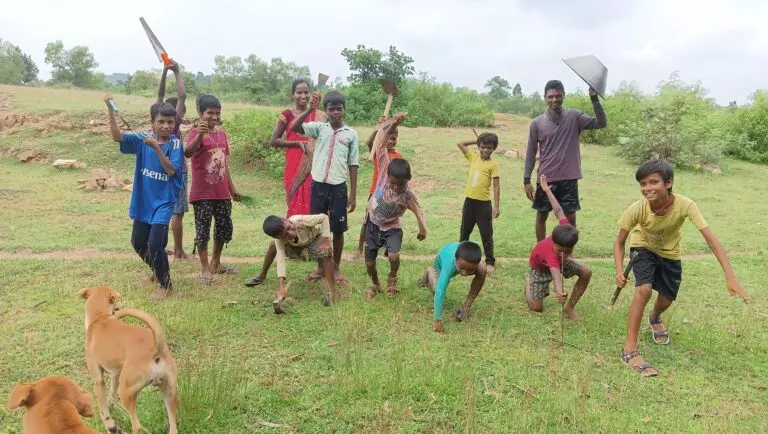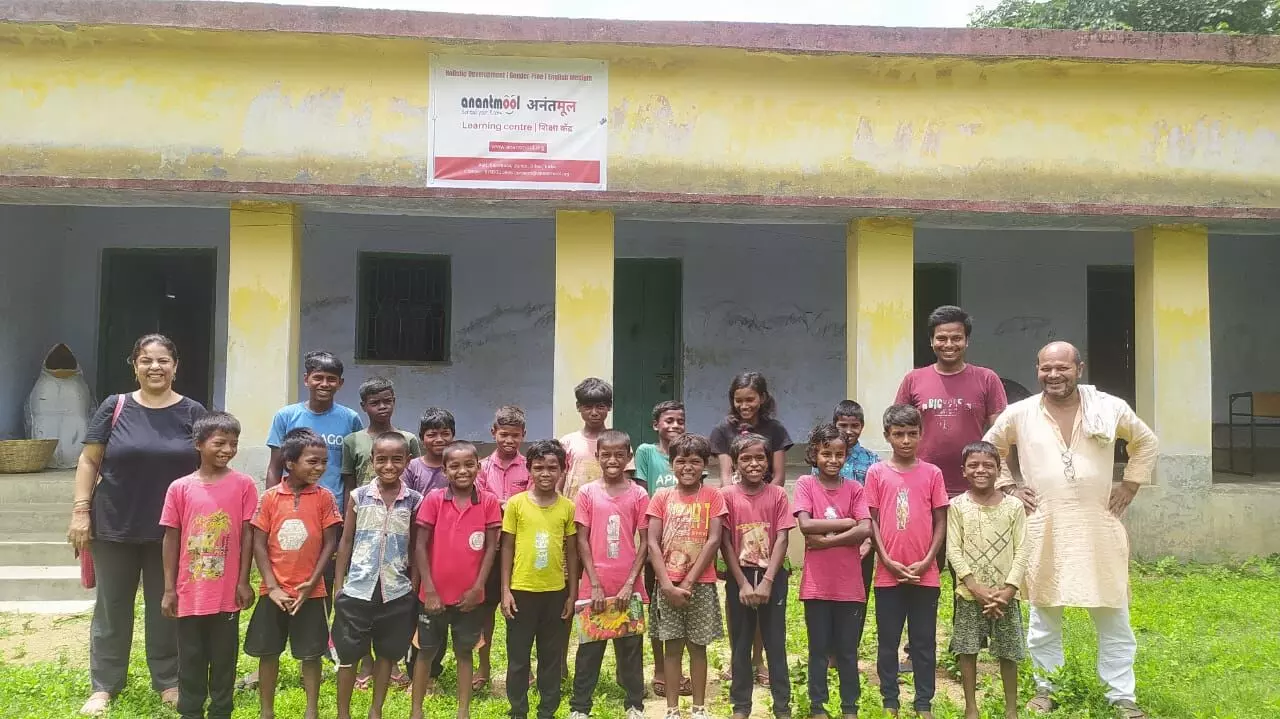It is Wednesday and Anantmool school is bustling as the children are preparing to bake a millet cake in a wood-fire oven. Wednesdays are community days, when the 55 adivasi children enrolled at the village school in Jamui district of Bihar cook, bake and clean.
The millet is a conscious choice, which was introduced by one of the the school’s founder Shivani Kumari, who tries to make her forest-inhabiting students include locally grown ingredients in the cooking class. The children also use mahua, mushrooms, and locally-produced millets to experiment with, in the school kitchen.
But, it took some time for Shivani and co-founder Niwas Kumar, to get their students on-board with the activities which many boys initially considered to be a girl’s chore.
Spread over half-an-acre of land in Nontara village of Chakai block, Anantmool is a gender-less school, trying to break the binary concepts of gender in children at the foundational level. A brainchild of Niwas and Shivani, Anantmool was set up as a learning centre in April, 2022 and had 30 enrollments at the start. Niwas is a native of Jamui.
The children studying at this school are made to question gender stereotypes at each step, from the games they play to the dress they wear to the sentences they encounter in their textbooks. Slowly and steadily, the gender-defined concepts of society are fading here.
Also Read: The Fondest Corner in a Govt Primary School

The school uses the government’s National Council of Educational Research and Training (NCERT) books in its curriculum.
The school uses the government’s National Council of Educational Research and Training (NCERT) books in its curriculum. But a course correction unfolds here almost every day.
For example, a game locally called Kit-Kit or hopscotch, was fondly played by both boys and girls here but the textbook identified the game as a girl-specific one. “Any game can be played by anyone,” 11-year-old Parmeshwar, a student at Anantmool told Gaon Connection.
“Like our book said that kit-kit is played by girls, but even I play it. I think it’s written wrong,” he said.
The students then corrected that sentence in the textbook to not make a mistake in future. Rather than theoretically teaching the students about gendered concepts, the teachers here create practical situations for them to question it themselves.
‘Choose for Yourself’
Presently, Anantmool caters to adivasi children from three villages. The school has settled well amongst the local community, and many students trek through forests to come to study here.
The special ‘tree-classes’ of Anantmool are much talked about!
Everyday, the students along with their teachers climb on the trees in the school campus, to study English. The approach hits two birds with a single arrow.
First, when the students are to climb the tree, they question the gender-defined dress code of trousers and skirts. If they realise that climbing might be easier in trousers, they would slowly switch to that.

Spread over half-an-acre of land in Nontara village of Chakai block, Anantmool is a gender-less school, trying to break the binary concepts of gender in children at the foundational level.
Secondly, English is an uneasy subject for them. When they sit on a tree while studying this, their mind is so preoccupied balancing themselves, that they drop the English-induced nervousness.
“It’s not that they switched to trousers on their own, we questioned them if climbing trees is more comfortable in a trouser and then eventually they switched,” Shivani explained.
Also Read: ‘We teach them A for Arjun; A for Abdul Kalam’
The efforts are showing in the response of children. Parmeshwar, who has been attending Anantmool for two months, is elated. Here, he either addresses his educators by their name or as ‘teacher’— a gender-neutral term as compared to ‘sir’ or ‘madam’.
Regarding the school uniform, Parmeshwar, a 11-year-old, feels that there should be no barrier in what anybody wants to wear. “The girls in my school wear trousers,” he said.
Rina has also been studying in Anantmool for a year and her favourite game is football. Her peers, Pradipa, Anita, Debashish and Parmeshwar, are trying hard to catch up with the 11-year-old’s goalkeeping skills.
“I walk to school every morning with my friends to get here at eight. I love playing football with my friends and the best player is Rina. I can never score a goal when she is the goalkeeper,,” Parmeshwar told Gaon Connection.
Seeds of change
The idea started brewing in Niwas’s mind, after he pursued his Masters in Education from Azim Premji University, Bengaluru.
“I interacted with the transgender community there and realised how the societal concept of binary gender norms keeps them at the periphery of any social schemes or institutions. This seemed like a vicious cycle,” the 26-year-old educator said.
Niwas’s initial idea was to create employment opportunities for the transgender community. But soon enough, he realised that the core problem lies at the much earlier stage, at the foundational stage of learning. Eventually, he got acquainted with Shivani, in Bihar, who was inclined to build an alternative education system. And that is how Anantmool was born. Anantmool derives its name from a tiny aromatic herb which grows in Asia and has deep roots, making it almost impossible to uproot it.
“Over the period of time, I also realised that the binary gender system creates problems for everyone. Growing up, I had studied in a boys only school. When I pursued higher education, I had to interact with many people from different genders than mine, and it was so difficult. What good does this do,” he questioned.
Also Read: A teacher holds ‘exclusive’ classes to educate rural girls about menstrual hygiene
The Education Space in Scarcity
“There are no anganwadi centres or primary schools in Nontara village and hence Anantmool fills that gap for the children,” Shivani told Gaon Connection.
The initial hurdle of proving that a gender-free learning space is possible, has been achieved by Anantmool. Now, the next step to scale awaits.
Amongst a rural community, where there are many gender barriers and gender-defined roles, Anantmool is taking small steps to normalise the gender-free education model. This would have been impossible without acquiring community trust.
“When we approached the community, we understood that they long to hear their children speak in English,” Niwas told Gaon Connection.
The teachers at the school put efforts to make every child learn spoken-English, and organised speeches on special occasions where the parents witnessed their wards showcase their English-speaking skills.
“It was a proud moment for them. Children who couldn’t speak Hindi properly, were giving speeches in English,” Niwas said enthusiastically.




















